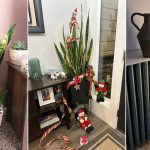Hatiora salicornioides is a quirky plant that is a must-have if you want something different. Here’s all about Bottle Cactus care.
Find how to take care of Hatiora salicornioides, a unique succulent plant also popular as Dancing Bone Cactus. It’s like nature’s way of giving your space a little confetti—bright, festive, and totally unique! So, learn the essential care tips to help it grow healthy and look beautiful.
Hatiora Salicornioides Information
Hatiora Salicornioides is originally from Brazil and thrives as an epiphyte in the rainforest. Its stems lack spines, although older specimens may display a few spiny formations near the lower portion. When fully grown, the dancing bone cactus stands at a height of 12 to 18 inches (31 to 46 cm).
It produces bell-shaped flowers in a beautiful orange-yellow color. These blooms are approximately 0.8 inches (2 cm) long and bloom at the tips of younger stem segments during the late winter to early spring period.
If you live in USDA zones 10 to 12, you can grow this plant outside. If not, no worries! It’s happy indoors too, thriving in apartments or any cozy corner with enough light.
Common names include Dancing Bones, Drunkard’s Dream, Spice Cactus, and Bottle Cactus—it’s a plant with character!
Propagating Hatiora Salicornioides
Propagating Hatiora salicornioides is easier than you might think, especially using stem cuttings, which is the most reliable method. Start by selecting healthy, mature stems and cutting them just below a node (where the leaves sprout). Just, make sure each cutting is about 3-4 inches long, and gently remove any leaves near the base. And, let these cuttings sit in a warm, dry spot away from direct sunlight for a few days to form a protective callus, which helps prevent rotting.
When it’s ready, plant the cutting in a small pot with well-draining cactus soil. Keep it in bright, indirect sunlight, and maintain a temperature of 70-80°F (21-27°C). Then, mist it lightly every few days to keep the humidity up, but don’t overwater—nobody likes soggy feet, not even plants! In a few weeks, roots will form, and you’ll see new growth. That’s your cue to move it to a slightly bigger pot.
Requirements for Growing Hatiora Salicornioides
Location
This plant loves its sunshine—5-6 hours a day is ideal. But don’t let it bake in harsh afternoon sun, especially in hot climates. Indoors, a south-facing window with sheer curtains works perfectly to mimic its natural habitat.
Soil
Well-draining soil is the way to go. A mix of sand, loam, and peat works wonders, or you can use a commercial cactus mix. Want to take it up a notch? Add some perlite, pumice, or coarse sand for better drainage.
Water
Water consistently, letting the soil dry slightly between sessions. In winter, reduce watering since the plant doesn’t need as much moisture. Overwatering can cause problems like root rot or yellowing leaves.
Here is a tip, you can use lukewarm water when watering in winter to prevent shocking the plant’s roots.
Temperature
Hatiora salicornioides likes moderate temperatures between 60°F (15°C) and 75°F (24°C). It can tolerate slightly cooler temperatures down to 50°F (10°C) for short periods, but prolonged exposure to colder temperatures may harm the plant.
The plant appreciates moderate to high humidity levels. It thrives in humidity ranges between 40% and 60%. However, it can adapt to lower humidity levels as well, as long as it receives adequate moisture and is not exposed to excessively dry conditions.
In dry indoor environments, placing a small humidifier or a tray of water near the plant can help maintain suitable humidity levels.
Hatiora salicornioides Care
Fertilizer
To nourish Hatiora salicornioides, you can use balanced liquid fertilizer, after diluting it to 1/4 of its strength, once a month throughout the year, except during the coldest part of winter. Just, avoid over-fertilizing, as it can lead to weak, leggy growth. A little goes a long way when it comes to feeding this cactus.
Pests and Diseases
The plant is generally free from major pests and diseases, but mealybugs can be a concern. If mealybugs appear, remove them with a damp cloth or cotton swab. If they persist, use an insecticide.
Take care with watering to avoid overwatering, which can cause yellowing leaves or leaf drops. Too much of a good thing can spell trouble for your cactus, so monitor water usage and reduce watering if needed. Plus, regularly inspect the plant for any signs of stress or pest infestation, as early detection can prevent bigger problems.
Growing Hatiora Salicornioides is a joy for plant lover who loves low-maintenance beauty. Do you have any tips or experiences with this plant? Don’t keep it under your hat—share your thoughts in the comments below!










